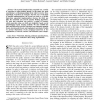Free Online Productivity Tools
i2Speak
i2Symbol
i2OCR
iTex2Img
iWeb2Print
iWeb2Shot
i2Type
iPdf2Split
iPdf2Merge
i2Bopomofo
i2Arabic
i2Style
i2Image
i2PDF
iLatex2Rtf
Sci2ools
PAMI
2010
2010
Watershed Cuts: Thinnings, Shortest Path Forests, and Topological Watersheds
We recently introduced the watershed cuts, a notion of watershed in edge-weighted graphs. In this paper, our main contribution is a thinning paradigm from which we derive three algorithmic watershed cut strategies: the first one is well suited to parallel implementations, the second one leads to a flexible linear-time sequential implementation whereas the third one links the watershed cuts and the popular flooding algorithms. We state that watershed cuts preserve a notion of contrast, called connection value, on which are (implicitly) based several morphological region merging methods. We also establish the links and differences between watershed cuts, minimum spanning forests, shortest-path forests and topological watersheds. Finally, we present illsutrations of the proposed framework to the segmentation of artwork surfaces and diffusion tensor images.
Intelligent Agents | Minimum Spanning Forests | PAMI 2010 | Popular Flooding Algorithms | Watershed Cuts |
| Added | 20 May 2011 |
| Updated | 20 May 2011 |
| Type | Journal |
| Year | 2010 |
| Where | PAMI |
| Authors | Jean Cousty, Gilles Bertrand, Laurent Najman, Michel Couprie |
Comments (0)

